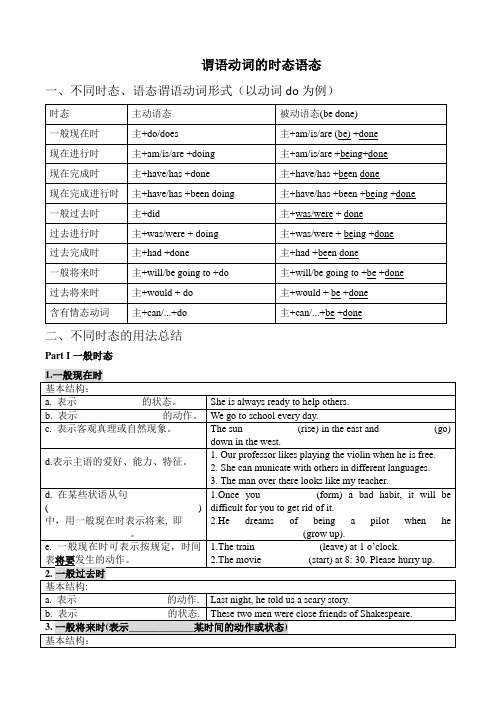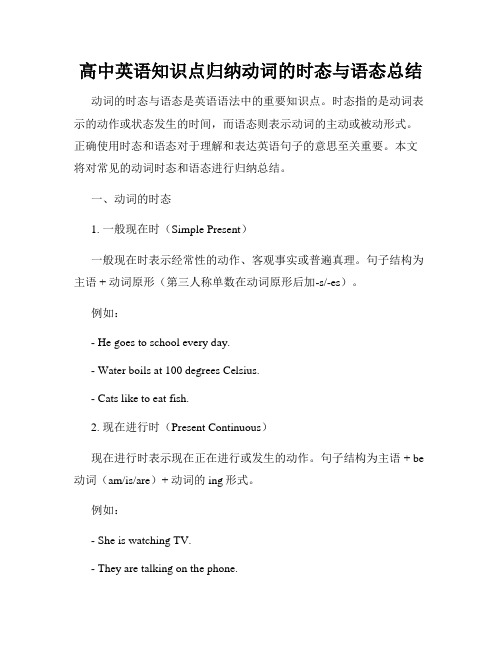高中动词时态和语态总结
高中语法动词的时态和语态

一、一般现在时1、表示经常发生的习惯性的、现在反复出现的动作或状态,常用的时间状语有:always,usually,seldom, sometimes, every day, now and then, once a week等。
2、表示眼下或目前等现在时间所发生的动作或存在的状态,这种状态带有一定的持续性。
3、表示客观事实或普遍真理。
4、书报的标题,故事的叙述,小说、戏剧、电影等情节介绍,图片的说明等。
5、时间表、时刻表、日程表、节目单、课程表等按规定将要发生的动作,只限于go, arrive, leave, start, stay, return, begin, come等动词。
6、在时间、条件、方式、让步状语从句中,表示将来的动作。
注意:一般现在时可以用于定语从句或宾语从句中表示将来。
7、用在某些表达中,表示现在正在发生的动作或存在的状态。
Here comes the bus!How it rains!二、一般过去时1、表示在过去某一时间点发生的动作或所处的状态,与现在没有关系。
常用的时间状语有:yesterday, last night, at that time等。
2、表示在过去某一段时间里反复出现的动作或状态,与现在没有关系。
3、用used to do或would do表示过去经常或反复发生的动作。
4、有些情况发生的时间没清楚表明,但实际上是“刚才,刚刚”发生的,属于过去时间,应使用过去时态。
常见的有I didn’t know…或I forgot…等。
5、一般过去时可与today, this week, this month等时间状语连用。
三、一般将来时1、will/shall do(1)表示将来会出现的动作或状态。
常用的时间状语:this evening, tomorrow, next week/month…,at the end of this term, in a few minutes等。
高中英语动词的时态和语态

高中英语动词的时态和语态1、表示在过去某一时间点发生的动作或所处的状态,与现在没有关系。
常用的时间状语有:yesterday, last night, at that time等。
2、表示在过去某一段时间里反复出现的动作或状态,与现在没有关系。
3、用used to do或would do表示过去经常或反复发生的动作。
4、有些情况发生的时间没清楚表明,但实际上是“刚才,刚刚”发生的,属于过去时间,应使用过去时态。
常见的有I didn’t know…或I forgot…等。
5、一般过去时可与today, this week, this month等时间状语连用。
三、一般将来时1、will/shall do(1)表示将来会出现的动作或状态。
常用的时间状语:this evening, tomorrow, next week/month…,at the end of this term, in a few minutes等。
(2)表示将来经常发生的动作。
(3)表示事物的固有属性或必然趋势、倾向。
(4)表示说话过程中做出某种决定。
注意:条件状语从句中的will表示“决心,意愿”,此时will是情态动词表示意愿。
2、be going to do(1)表示已经决定或安排要做的事。
(2)表示根据某种迹象认为在最近或将来将要发生的事。
3、be to do(1)表示约定、计划或按职责、义务要求即将发生的动作。
(2)表示说话人的意志、意图、职责、义务、命令。
(3)表示注定要发生的事情。
4、be about to do(1)表示即将发生的动作,意为“正要,即将”。
(2)不可与表示具体的将来时间的副词或副词性短语连用,但可以同由as或when 引导的时间状语从句连用。
5、某些动词的现在进行时表示即将发生的动作。
四、过去将来时1、would/should do表示从过去某一时间来看将要发生的动作或将要存在的状态。
通常用于其主句的谓语为过去时态的宾语从句中。
高中时态语态归纳总结导学案高考英语一轮复习

谓语动词的时态语态一、不同时态、语态谓语动词形式(以动词do为例)二、不同时态的用法总结Part I一般时态三、被动语态时态语态专练一.画出下列句子(包括从句)中的谓语动词,并写出其时态语态。
1.This afternoon, we had our chemistry class in the science lab.2. She is studying at an American high school for a year.3. My name is Adam and I’m a freshman at senior high school.4. You should encourage your friend to try new hobbies.5. There, a boat will take you to stay with a local Urus family on an island for three days.6. I’ve been studying English since primary school.7. The team that Lang Ping had built was falling apart.8. One of the best players had been injured, and the team captain had to leave because of heart problems.9. Foreign aid is being organized for the tsunamihit countries.10. China’s ancient civilization has continued all the way through into modern times.11. Some of the symbols can still be seen in today’s hanzi.12. Listening to English radio programme helps me to get used to an English language environment.13. Water from the dam would likely damage a number of temples and destroy cultural relics.14. A mittee was established to limit damage to the Egyptian buildings and prevent the loss of cultural relics.15. Nearly 500,000 highquality digital photographs have been produced since the international project started in 1994.16. Billions of trees are being cut down every day to make paper for humans.17. I sincerely hope that you will be admitted to your ideal university.18. When I was a little child, I once said to my grandmother that I would buy her a big house. 二.用括号里动词的正确形式填空1. A meeting _____________(hold) in Nanjing from March 22 to 24, 2023.2. Then, one day in 1945, Marcel ____________(give) another opportunity by the mountain.3. Since then, Marcel __________(make) mountain climbing his life’s work.4. Spending too much time online ________(make) it difficult to focus on other things in life.5. When I got to the theater, I found out that the tickets __________________________(sell out).6. In the last few years, thousands of films ________________________(produce) all over the world.7. In the near future, more advances in science technology _______________________(make) by scientists.8. The experts are discussing how the cultural relics can _________(save).9. With the help of my teacher, I __________(make) great progress in English so far.10. Tom _________(visit) his grandparents every weekend.11. The problem ______________(solve) sooner or later.12. I ______________(do) my homework in my room as usual when I heard someone screaming.13. The pany _____________(develop) a new app and it will appear on the market next year.14. I went to Ningxia and __________(stay) there for a year.15. Could I use your car? Mine ________________(repair) in the garage now.16. The book __________________(translate) into many languages since it _____________(publish) in 1973.17. He promised that he_____________(marry) me, but three months later he went abroad.18. An autumn outing _______________(hold) next Friday by our school to enrich our school life .19. The China International Search and Rescue Team (CISAR) ____________(form) in 2001 and is now made up of several hundreds of rescue workers and about 20 sniffer dogs.20. Rescue workers ___________(train) to find people, treat injuries, and hand out food, water, and other supplies.21. In 1961, the first temple __________(move) by German engineers.22. When the project ended in 1980, it ___________(consider) a great success.23. This semester is about to end. M y parents and I ______________(travel) to Xi’an this winter vocation.24. On most Sundays, the sounds of hammers and other tools striking stones can ____________(heard) in Xochiaca, an ancient village in Mexico.25. The ChineseCanadian _______(win) the 18th International Chopin Piano petition in Warsaw in 2021 at the age of 24.。
(完整版)高中语法之常用时态语态详解

第四章时态和语态一.动词的时态英语时态用共有十六种时态,其中常用的有8种,它们是:一般现在时、一般过去时、一般将来时、现在进行时、现在完成时、过去进行时、过去完成时和过去将来时。
一. 一般现在时.1.构成. be动词:am is are ; 其他动词用动词原形,当主语是第三人称单数时要在谓语动词后加“s”,其变化规则与名词变复数一致。
2.用法. 1). 经常性或习惯性的动作,常与表示频度的时间状语连用。
如usually, always, often, seldom, never, every...,eg. I leave home for school at 7 every morning.I don’t leave home for school at 7 every morning.Do I leave home for school at 7 every morning?He usually gets up early.He doesn’t usually get up early.Does he usually get up early?2) 客观真理,客观存在,科学事实。
eg. The earth moves around the sun.The earth doesn’t move around the sun 否定句Does the earth move around the sun? 疑问句Shanghai lies in the east of China.Shanghai doesn’t lie in the east of China 否定句Does Shanghai lie in the east of China? 疑问句Water boils at 100 centigrade degrees.3) 表示格言或警句中eg. Pride goes before a fall.注意. 此用法如果出现在宾语从句中,即使主句是过去时,从句谓语也要用一般现在时。
动词时态和语态总结

四、现在进行时 1.表示说话时正在进行而尚未完成的动作或状态。
We are having an English lesson. 2.表示现阶段一直在进行的动作,但说话时不一定正在进行。
The workers are building a new factory.
3.有时可表示即将发生的动作〔只限于go, come, stay, leave, start, begin, arrive, return, fly, drive等动词〕这时常有一个
played table tennis almost everyday. 4〕在条件、时间状语从句中表示过去将来的动作。
They said they wo精u品lPdPTlet us know if they heard any news about him.
三. 一般将来时 一般将来时表示将来要发生的动作和存
精品PPT
二、一般过去时 1〕表达特定的过去时间内发生的动作或存在的状况,
常与last week/year/ month/ spring, a few days ago, in 1998等时间状语以及when等连词引
导的时间状语从句连用。
We had a good swim last Sunday.
3〕用在问句中,表示委婉礼貌; Will you be reading anything else? When shall we be meeting again?
When I was young, I took cold baths regularly. 2〕表达过去连续发生的一件件事。
He got up early in the morning, fetched water,
高中英语知识点归纳动词的时态与语态总结

高中英语知识点归纳动词的时态与语态总结动词的时态与语态是英语语法中的重要知识点。
时态指的是动词表示的动作或状态发生的时间,而语态则表示动词的主动或被动形式。
正确使用时态和语态对于理解和表达英语句子的意思至关重要。
本文将对常见的动词时态和语态进行归纳总结。
一、动词的时态1. 一般现在时(Simple Present)一般现在时表示经常性的动作、客观事实或普遍真理。
句子结构为主语 + 动词原形(第三人称单数在动词原形后加-s/-es)。
例如:- He goes to school every day.- Water boils at 100 degrees Celsius.- Cats like to eat fish.2. 现在进行时(Present Continuous)现在进行时表示现在正在进行或发生的动作。
句子结构为主语 + be 动词(am/is/are)+ 动词的ing形式。
例如:- She is watching TV.- They are talking on the phone.- We are studying for the exam.3. 一般过去时(Simple Past)一般过去时表示发生在过去的动作或状态。
句子结构为主语 + 动词过去式。
例如:- I visited my grandparents last weekend.- He studied English in high school.- They went to the concert together.4. 过去进行时(Past Continuous)过去进行时表示过去某个时间点正在进行或发生的动作。
句子结构为主语 + was/were + 动词的ing形式。
例如:- She was cooking dinner when I called her.- They were playing soccer at the park yesterday.- We were watching a movie when the power went out.5. 一般将来时(Simple Future)一般将来时表示将来某个时间要发生的动作。
高中时态和语态

The more you give him, the more he wants.
1. Would you please give him the message the
moment he _____ ?
表示最近或按计划Βιβλιοθήκη 排的动作:The bus is arriving at Xingzhuang station(stop). I’m very sad because my old dog is dying.
1. - Is this raincoat yours?
- No, mine ____ there behind the door.
一般将来时小节:
1. will/ shall +动词原形 表示将来发生的动作或状态. 2. be going to do表示最近人的打算,意图或
What do you think of (about) the new teacher? 比较:What are you thinking about? ( “思考”不是“认为”)
表示感觉的动词不用进行时,而用一般现在时, 如:feel, taste, smell, look…
表示状态的词, 如:contain, include, have, exist, belong等不用进行时
7. At the end of the meeting, it was announced that
an agreement ______.
A.has been reached B√.had been reached
C.has reached
高中英语 动词时态和语态

4. 现在进行时 【例】 We are waiting for you now. 我们正在等你。 【例】 He is teaching in a middle school. 他在一所中学教书。 【例】 I'm meeting my father at the station at 5 o'clock. 我五点要去车站接我的父亲。 (1)现在进行时的构成 现在进行时的构成形式为:am/is/are+v.-ing。v.-ing形式的变化规则如下:
ONE If you don't hurry, you will miss the train. 如果你不快点儿,你就会
赶不上火车。 表示事物的固有属性或必然趋势; Fish will die without water. 离开水,鱼就会死。 表示偶然的、临 时的决定。 -Do you know Mr. Smith has come to our town? -No.
Mrs. Peter went to the park to have a walk every day last year. 彼得太太去年每天都到公园去散步。
I went to the cinema once a week when I was at school. 我上学时每周去看一场电影。
ONE ③表示过去连续发生的动作。这种情况下,往往没有表示过去的时间
walk. 她早早起床、提水,打扫房间,然后出去散步。
④在表示时间、条件等的状语从句中代替过去将来时。
They said they would let me know as soon as they got there. 他们说只要他们一到那儿就会马上通知我。
- 1、下载文档前请自行甄别文档内容的完整性,平台不提供额外的编辑、内容补充、找答案等附加服务。
- 2、"仅部分预览"的文档,不可在线预览部分如存在完整性等问题,可反馈申请退款(可完整预览的文档不适用该条件!)。
- 3、如文档侵犯您的权益,请联系客服反馈,我们会尽快为您处理(人工客服工作时间:9:00-18:30)。
在高考英语中,动词的时态和语态是重中之重,试题在考查固定句式中的时态和语态的同时,注重在上下文语境中考查时态和语态。要了解几种时态的一些常规规则,答题时要研读题干,搜索出尽可能多的“时间参照信息”,尤其要注意时态的呼应情况。
表格(一)
时态
标志词
1.一般现在时态:
always,often, usually,sometimes, seldom ,never,
so far,, in / during the past / last + 一段时间 (2) for + 一段时间, since + 过去某一时
间 ; since + last…; since + 一段时间 + ago, since +从句.
8.过去完成时态
by the time (of), by the end of + 过去时间 when. before. after…+过去时间up till then (直到那时); up until last night(直到昨晚)。常常用在主句是过去时的宾语从句中(现在完成时态要调整为过去完成时态)
3.现在进行时态:
now, at the moment. It’s four o’clock . nowadays, Look,...Listen, ...
4.过去进行时态:
this/that time yesterday, at that moment at eight o’clock last night, from8 to 10 yesterday morning, when, while 等引导的时间状语从句等。
5.一般将来时态
(1) tomorrow, the day after tomorrow, tomorrow morning (2) next time, next Friday, next term, next month(3) in +一段时间;in +一段时间 ' s + time(4) soon = right away = at once (5) by the end of + 将来时间(6)later (on) ; in the future
6.过去将来时态
(1)the next time/ Friday/ term/ month (2)the following month (week…)(3)主句为过去时,宾语从句中原来的一般将来时要转换成过去将来时态。
7.现在完成时态
(1) already, yet, ever, never, just, before, recently, lately , once(twice..)
表格(二)
时态
主动语态形式
被动语态形式
一般现在时
am/is/are/do/does
am/is/are done
一般过去时
was/were/did
was/were done
现在完成时
has/have done
has/have been done
现在完成进行时
has/have been doing
/
现在进行时
一般将来时
will /shall do
am/is/are going to do
am/is/are coming/leaving
am/is/are to do
am/is/are about to do
will /shall be done
am/is/are to be done
过去将来时
would do
was going to do
was coming/leaving
was to do
was about to do
would bedone
was/were to be done
将来进行时
will /shall be doing
/
am/is/are doing
am/is/are being done
过去进行时
was/were doing
was/were being done
过去完成时
had done
had been done
将来完成时
will/shall have done
will /shall have been done
every day/week/month/year,
once a week, twice a week,
on SundΒιβλιοθήκη ys等。in the morning / afternoon / evening
2、一般过去时态:
yesterday, the day before yesterday(前天)last week(month ,year),two months ago, in 1990, in those days , long long ago=once upon a time just now(刚才)at the age of 5
